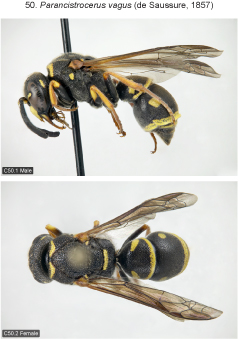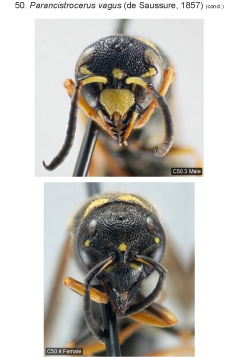
| Home | Table of contents | Keys | Species list | Glossary | Image data | PDF | Cite this article | Feedback | Updates |
Identification Atlas of the Vespidae (Hymenoptera, Aculeata) of the northeastern Nearctic region
CJAI 05, February 19, 2008
doi: 10.3752/cjai.2008.05
Matthias Buck, Stephen A. Marshall, and David K.B. Cheung
Department of Environmental Biology, University of Guelph, Guelph, Ontario, Canada N1G 2W1
Next species | Previous species | Key
50. Parancistrocerus vagus (de Saussure, 1857)
Figs B2.32; B7.8, 29, 51; C50.1–4.

|

|
Species recognition. This species is uniquely characterized by a small median depression on tergum 2 just below the hind margin of tergum 1 that serves as entrance to the acarinarium. Furthermore, the male has a deeply emarginate clypeal apex, unusually large mandibular teeth 2–4, and the pubescence of sterna 3–7 is conspicuously erect (but not particularly long) and somewhat brush-like (especially on sternum 7). In colouration and size the species closely resembles P. leionotus but it lacks the longish hairs on the summit of tergum 1, and the tegula, mid and hind tibiae are conspicuously tinged with amber-reddish, lacking clear yellow areas (except rarely the tibiae).
Variation. Fore wing length 6.5–8.0 mm (♂♂), 7.5–9.0 mm (♀♀). Interestingly, the median depression at the base of tergum 2 (entrance to the acarinarium) is sexually dimorphic: It is broad and shallow in the male, narrow and deep in the female. Overall, the size of the aperture is much larger in the male than in the female. If mites are transferred during copulation one might speculate that the larger opening allows the mites to leave the acarinarium more quickly in order to move over to the female. Thickening of apical margin of tergum 2 varies between 0.3–0.8x mid ocellar diameter (male) or 0.25–0.5x mid ocellar diameter (female). Female clypeus with a pair of yellow dorsal spots, often coalescent and forming a crescent-shaped mark; male clypeus sometimes with small to medium-sized, irregular black discal blotch. Interantennal spot sometimes extending almost to clypeus in male. Transverse pronotal band usually interrupted medially and very rarely laterally, sometimes more or less emarginate on each side. Spot on upper mesopleuron sometimes small or absent in male. Parategula usually marked with yellow, or sometimes with reddish-brown. Propodeum black in eastern Canadian specimens; specimens from more western or southern localities sometimes with a pair of more or less elongate lateral spots. Terga 1–(3)4 (female) or 1–(4)5(6) (male) with apical fasciae, the one on tergum 3 rarely interrupted medially but then fascia on tergum 4 reduced to a few spots or absent. Terga 1 and 2 with discal spots in both sexes, the former usually connected to apical fascia, the latter sometimes very small or absent, especially in small specimens. Female sternum 2 with usually more or less medially interrupted apical fascia, sternum 3 rarely with apicolateral spots; male sterna 2(–3) with apical fascia, the one on 2 often interrupted in eastern Canadian specimens (3 is then absent), evanescent fascia sometimes also present on sternum 1; small, blurred discal spots sometimes present on sternum 2 (observed in extralimital material from BC, VA, GA).
Distribution. Canada: ON, BC, newly recorded from SK and AB. Entire U.S. except Pacific Coast states (Krombein 1979). Mexico (Rodríguez-Palafox 1996). The reddish Floridian form was named ssp. slossonae (Bohart, 1948).
Biology. Builds free mud nests. Two described nests were attached to branches 0.6 and 1 m above the ground, had a size of ca. 2.5 cm (diameter) and 1.9 x 3.4 cm, and one contained 6 cells (Evans 1956, 1978). Eickwort (1973) describes a 5-celled mud nest in a crevice of a rock. The surface of the nest was perfectly flush with the rock surface. The identity of prey caterpillars has not been recorded.
Next species | Previous species | Key
| Home | Table of contents | Keys | Species list | Glossary | Image data | PDF | Cite this article | Feedback | Updates |
